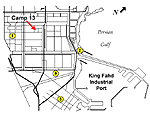
TAB E - Saudi Environmental Monitoring
The Saudi Royal Commission developed an extensive monitoring system to detect pollutants in the air, ground water, seawater, and wastewater. According to the US Navy’s Environmental and Preventive Medicine Unit Number 2, the monitoring staff was well-qualified and used state-of-the-art equipment to monitor, compile, and analyze data on a regular basis.[244]
Eight remote sensor stations monitored the air quality within the vicinity of Al Jubayl—seven stations located at various locations within Al Jubayl and the eighth monitoring station at KAANB. A mobile monitoring unit was also available. Figure 26 shows monitoring stations located within the immediate industrial area and port area during the war. The fixed stations had an equipment trailer and a sampling tower surrounded by a security fence. Each sampling tower had sensors installed at heights of 10, 50, and 90 meters (33, 164, and 296 feet respectively). The automated monitoring process relied on sensor data fed to on-site computers and transmitted to a central monitoring station every five minutes. Compiled on an hourly, daily, monthly, and yearly basis, the sensor data was compared to the Royal Commission’s standards.
Figure 26. Location of Air Quality Monitor Stations within the Industrial Area
Monitors were capable of detecting the following pollutants:
The sensors could only detect industrial pollutants and could not detect chemical warfare agents. All fixed sensor-monitoring stations were operational throughout Desert Shield and Desert Storm. As stated previously, Air Monitoring Station Number one was located 2 kilometers west of Camp 13. Tab F contains Monitoring Station Number one readings from August 1990 through June 1991 provided by the Royal Commission. The data shows no large-scale release of industrial chemicals or pollutants in the area near Camp 13.[245]
The water quality monitoring used a system of ten strategically placed monitoring stations. The Royal Commission established water quality standards that paralleled those of the US Environmental Protection Agency (EPA). Water quality monitoring included checking the water for total organic content, temperature, pH, total dissolved solids, and industry-specific pollutants. Wastewater was treated at either an industrial waste treatment plant or a sewage waste treatment plant, as appropriate. Proper treatment brought sanitary wastewater to a level that approached the quality of potable water for irrigation purposes.[246]
| First Page | Prev Page | Next Page |